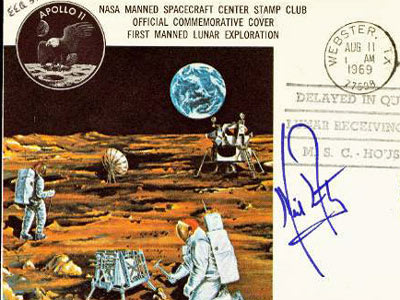After all the danger, glory, and fame it's easy to forget that at the end of the day astronauts are federal employees subject to the same General Schedule (GS) pay scale as everyone from typists to CIA agents.
Unfortunately, a federal salary wasn't enough for Apollo 11 astronauts to purchase life insurance.
When Neil Armstrong and the rest of the crew of Apollo 11 piled atop that huge rocket packed full of fuel in 1969 they were under no illusions that it may have been the last thing they ever did. Unfortunately, neither was anyone who might have insured their lives, and helped provide security for the astronauts' families in case they didn't come home.
Back then astronaut captains made about $17,000 a year,NPR reports and a life insurance policy for Neil Armstrong would have run about $50,000 a year, or more than $300,000 in 2012 dollars.
What the trio did to provide for their families has become somewhat of a low-flying legend, mentioned here on the website, UK Insurance.
It happened like this:
Because some guys from the prior Apollo missions had gotten colds and mild bouts of queasiness on their trips, NASA had implemented a quarantine procedure before liftoffs.
So about a month before they were set to go to the moon, Neil Armstrong, Michael Collins, and Buzz Aldrin were locked into a Plexiglas room together and got busy providing for their families the only way they could — they signed hundreds of autographs.
In what would become a common practice, the guys signed their names on envelopes emblazoned with various space-related images. The 'covers' would, of course, become intensely valuable should the trio perish on the mission. They're now often referred to as " Apollo Insurance Covers."
And to ensure the covers would hold maximum value, the crew put stamps on them, and sent them in a package to a friend, who dumped them all in the mail so they would be postmarked July 16, 1969 — the day of the mission's success — or its failure.
Fortunately, the trip went off without a hitch and all three men went on to live long, healthy lives and all remained alive until Neil Armstrong's death a few days ago.
The covers are still around, and not too hard to find. In 2011, Collectors Weekly pegged their average value at around $5,000.
Unfortunately, a federal salary wasn't enough for Apollo 11 astronauts to purchase life insurance.
When Neil Armstrong and the rest of the crew of Apollo 11 piled atop that huge rocket packed full of fuel in 1969 they were under no illusions that it may have been the last thing they ever did. Unfortunately, neither was anyone who might have insured their lives, and helped provide security for the astronauts' families in case they didn't come home.
Back then astronaut captains made about $17,000 a year,NPR reports and a life insurance policy for Neil Armstrong would have run about $50,000 a year, or more than $300,000 in 2012 dollars.
What the trio did to provide for their families has become somewhat of a low-flying legend, mentioned here on the website, UK Insurance.
It happened like this:
Because some guys from the prior Apollo missions had gotten colds and mild bouts of queasiness on their trips, NASA had implemented a quarantine procedure before liftoffs.
So about a month before they were set to go to the moon, Neil Armstrong, Michael Collins, and Buzz Aldrin were locked into a Plexiglas room together and got busy providing for their families the only way they could — they signed hundreds of autographs.
In what would become a common practice, the guys signed their names on envelopes emblazoned with various space-related images. The 'covers' would, of course, become intensely valuable should the trio perish on the mission. They're now often referred to as " Apollo Insurance Covers."
And to ensure the covers would hold maximum value, the crew put stamps on them, and sent them in a package to a friend, who dumped them all in the mail so they would be postmarked July 16, 1969 — the day of the mission's success — or its failure.
Fortunately, the trip went off without a hitch and all three men went on to live long, healthy lives and all remained alive until Neil Armstrong's death a few days ago.
The covers are still around, and not too hard to find. In 2011, Collectors Weekly pegged their average value at around $5,000.
MORE FROM 
@YahooFinance on Twitter, become a fan on Facebook





No comments:
Post a Comment